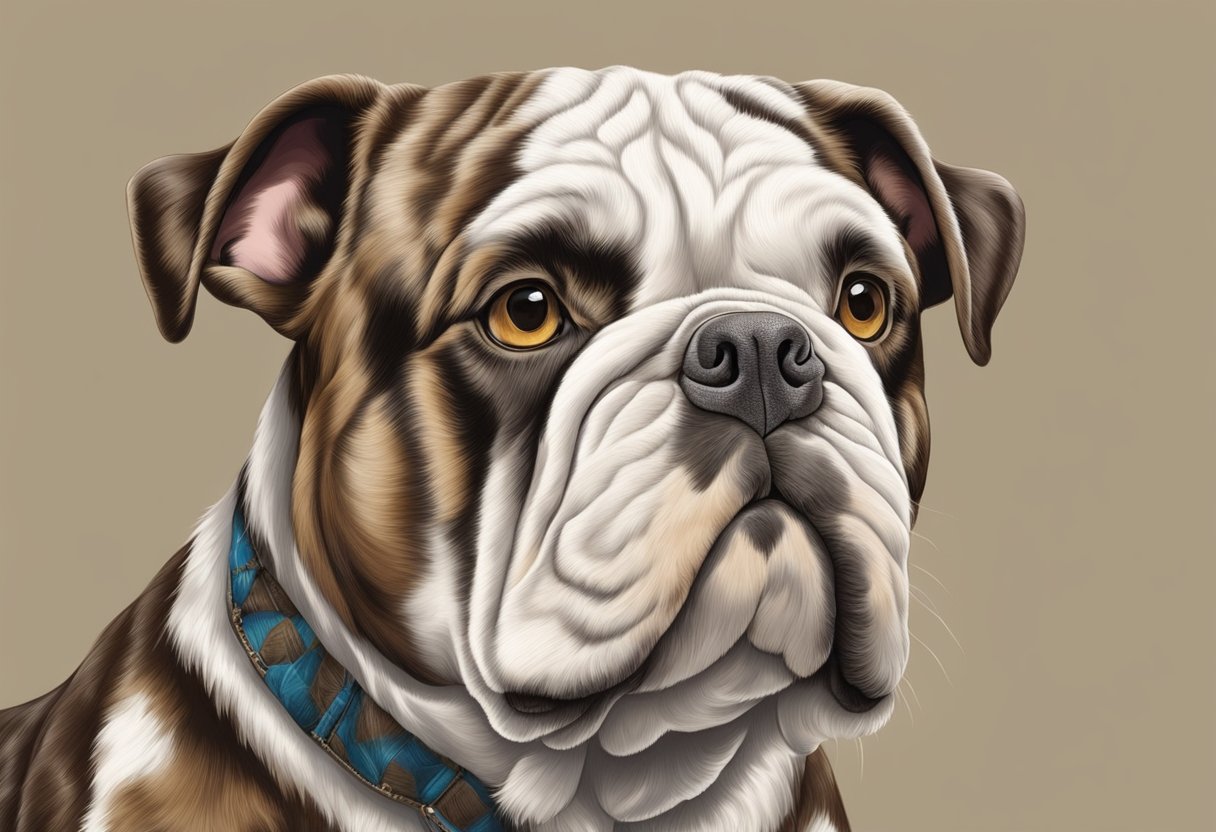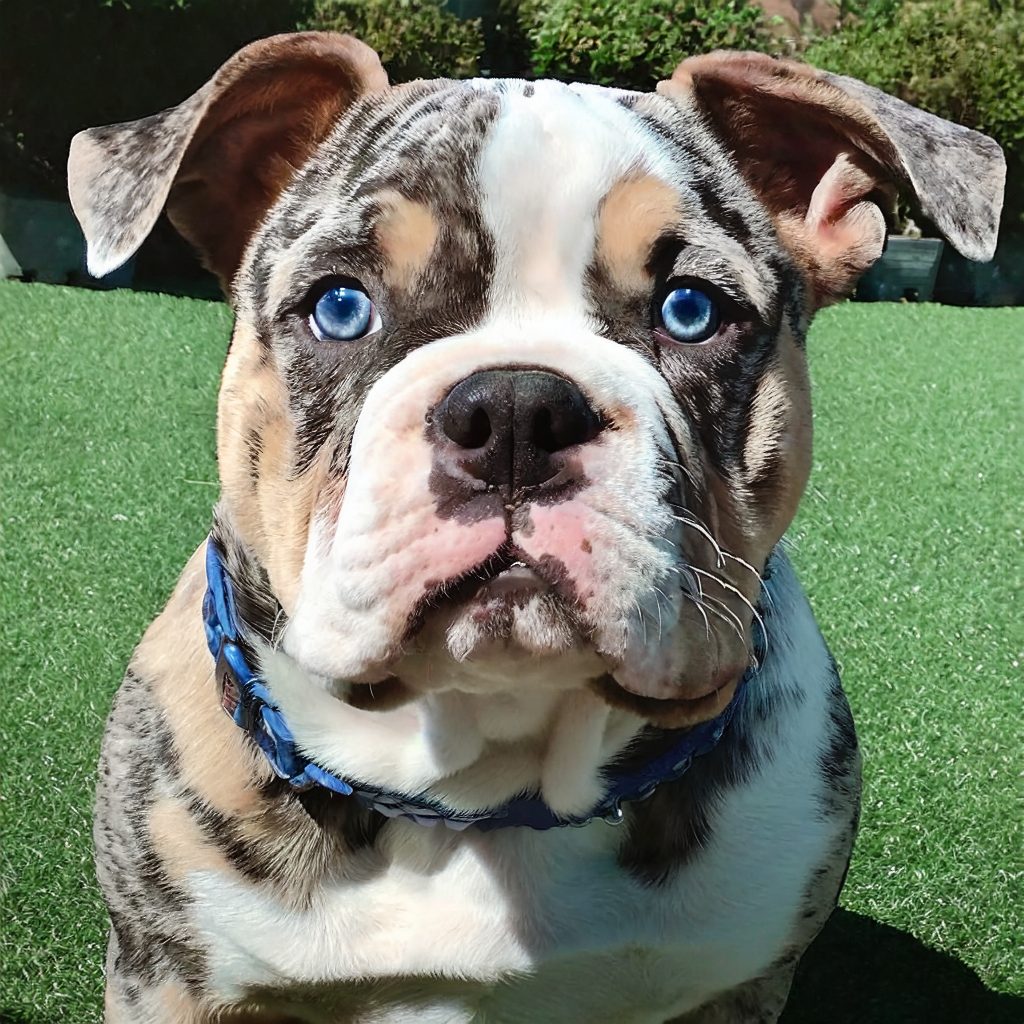Chocolate merle bulldogs are a unique and rare color pattern in the English bulldog breed. The coat of a chocolate merle bulldog is characterized by a marbled or mottled pattern with patches of darker colors. These patches can range from chocolate brown to black and can be seen on a lighter colored base coat.
The chocolate merle bulldog’s coat is a result of the merle gene, which is responsible for the unique coloring. However, the merle gene can also cause health problems such as deafness, blindness, and other eye abnormalities. It is important for potential owners to understand the risks associated with this gene before deciding to bring home a chocolate merle bulldog.
Key Takeaways
- Chocolate merle bulldogs have a unique and rare coat pattern.
- The merle gene responsible for the coat pattern can also cause health problems.
- Potential owners should be aware of the risks associated with the merle gene before bringing home a chocolate merle bulldog.
History of Chocolate Merle Bulldogs

The Chocolate Merle Bulldog is a relatively new breed that has gained popularity in recent years. The exact origin of the Chocolate Merle Bulldog is not clear, but it is believed to have originated from a crossbreeding between a Bulldog and a Merle-colored dog, most likely from a breed that has the Merle coloring.
Merle is a genetic pattern that can occur in dogs, characterized by patches of diluted pigment on a solid base color. The Merle gene can produce a range of coat patterns and colors, including blue, chocolate, and fawn. The Chocolate Merle Bulldog has a chocolate base color with patches of diluted pigment, creating a unique and striking appearance.
Chocolate Merle Bulldogs are fairly rare because the chocolate color is a recessive gene. Breeders need to carefully select and breed dogs with the chocolate gene to produce Chocolate Merle puppies. As a result, Chocolate Merle Bulldogs can be more expensive than other Bulldog varieties.
Despite their recent popularity, Chocolate Merle Bulldogs are not recognized by the American Kennel Club (AKC) or other major kennel clubs. However, some breeders are working to establish the Chocolate Merle Bulldog as a distinct breed, separate from other Bulldog varieties.
Physical Characteristics of Chocolate Merle Bulldogs

Chocolate Merle Bulldogs are a unique and rare color pattern in the Bulldog breed. Their coat is characterized by a marbled or mottled look, with colored patches dispersed over a lighter foundation coat. The color of the coat is caused by a genetic mutation that affects the distribution of pigment in the hair.
In addition to their striking coat pattern, Chocolate Merle Bulldogs have other distinctive physical characteristics. They have a muscular build and a stocky, compact frame. Their head is large and square, with a short, broad muzzle and prominent wrinkles. Their eyes are usually blue or have a marbled appearance, which is a result of the merle gene. Their nose is usually black or mottled black and pink.
Chocolate Merle Bulldogs are smaller than other Bulldog breeds, typically weighing between 40 and 50 pounds and standing between 12 and 16 inches tall at the shoulder. They have a short, smooth coat that requires minimal grooming.
Due to their unique coloring and distinctive physical characteristics, Chocolate Merle Bulldogs are highly sought after by Bulldog enthusiasts. However, it is important to note that the merle gene is controversial and can cause health issues in some dogs. It is important to research the breed and choose a reputable breeder who has taken steps to ensure the health and well-being of their dogs.
Health Issues and Lifespan
Merle English Bulldogs have a lifespan of around 10 to 12 years, which is similar to other English Bulldog colors. However, like all purebred dogs, they are prone to certain health issues. Here are some of the health issues that Merle English Bulldogs may be at risk for:
- Deafness: Merle English Bulldogs are at a higher risk of being born deaf or developing deafness later in life. This is because the merle gene is linked to a gene that causes deafness in dogs.
- Eye problems: Merle English Bulldogs may be at risk of developing eye problems such as cataracts, glaucoma, and progressive retinal atrophy. It is important to have their eyes checked regularly by a veterinarian.
- Breathing problems: English Bulldogs, in general, are prone to breathing problems due to their short snouts. Merle English Bulldogs may be at a higher risk of developing breathing problems due to their unique coat pattern.
- Skin problems: Merle English Bulldogs may be at risk of developing skin problems such as allergies and dermatitis. It is important to keep their skin clean and dry to prevent these issues.
It is important to note that not all Merle English Bulldogs will develop these health issues. However, it is important to be aware of the potential risks and to take steps to prevent them. Regular check-ups with a veterinarian and proper care can help ensure that your Merle English Bulldog lives a long and healthy life.
Grooming and Care
Chocolate Merle Bulldogs require regular grooming to maintain their coat’s health and appearance. Brushing their coat once a week is recommended to spread the natural oils and remove any loose hair. This can also help detect any signs of skin issues early on.
It is important to bathe the dog only when necessary, as over-bathing can strip their coat of natural oils and cause skin irritation. Use a mild dog shampoo and conditioner, and be sure to rinse thoroughly. Dry the dog with a towel or blow dryer on a low heat setting.
Their ears should be checked regularly for signs of infection or irritation. Clean them with a damp cloth or cotton ball and avoid using cotton swabs, which can push debris further into the ear canal.
Their teeth should be brushed regularly to prevent dental issues. Use a soft-bristled toothbrush and dog toothpaste to gently scrub their teeth and gums.
Regular visits to the veterinarian are necessary to ensure the dog’s overall health and well-being. Vaccinations, parasite prevention, and routine check-ups are essential.
Proper exercise and a healthy diet are also crucial in maintaining a Chocolate Merle Bulldog’s health. A balanced diet with high-quality protein and limited processed ingredients is recommended. Avoid overfeeding and provide plenty of water.
Feeding and Nutrition
Feeding a chocolate merle bulldog is not much different from feeding any other French bulldog. They have similar dietary requirements as any other dog, but it’s important to choose the right food and feeding habits to keep them healthy and happy.
Choosing the Right Food
It’s important to choose high-quality dog food that meets the nutritional needs of your chocolate merle bulldog. Look for dog food that contains high-quality protein, healthy fats, and essential vitamins and minerals. Avoid dog food that contains fillers, artificial preservatives, and additives.
It’s recommended to feed your chocolate merle bulldog a diet that is high in protein and low in carbohydrates. Look for dog food that contains meat as the first ingredient, such as chicken, lamb, or beef. Avoid dog food that contains by-products or meat meal.
Feeding Habits
It’s recommended to feed your chocolate merle bulldog two to three small meals a day instead of one large meal. This will help prevent digestive issues and keep their energy levels stable throughout the day.
Make sure to provide plenty of fresh, clean water at all times. French bulldogs are prone to dehydration, so it’s important to make sure they have access to water at all times.
Avoid Overfeeding
Chocolate merle bulldogs are prone to obesity, so it’s important to avoid overfeeding them. Follow the feeding guidelines on the dog food package and adjust the amount based on your dog’s activity level and weight.
Avoid feeding your chocolate merle bulldog table scraps or human food. This can lead to digestive issues and obesity.
Supplements
Supplements can be beneficial for your chocolate merle bulldog’s health, but it’s important to talk to your veterinarian before adding any supplements to their diet. Common supplements for French bulldogs include probiotics, joint supplements, and omega-3 fatty acids.
Training and Behavior
Training and behavior exercises are essential for keeping a chocolate merle bulldog healthy and happy. From a young age, the dog should be taught to do and respond to things like sit, stay, come, and down. Positive reinforcement techniques such as praise and treats should be used to encourage good behavior.
Socialization is also crucial for a chocolate merle bulldog. They should be exposed to different people, animals, and environments to help them feel comfortable and confident in various situations. This can help prevent behavioral issues such as fear or aggression.
Consistent training and positive reinforcement are key to preventing undesirable behaviors such as excessive barking, chewing, or digging. Providing the dog with plenty of physical and mental stimulation, such as daily walks and interactive toys, can also help prevent boredom and destructive behavior.
It is important to note that some chocolate merle bulldogs may have a higher prey drive than others, and may require extra training to avoid chasing after small animals. It is also important to supervise the dog around children and other pets to prevent any potential conflicts.
Overall, with proper training and socialization, a chocolate merle bulldog can make a loyal and well-behaved companion.
Breeding and Genetics
Understanding Merle Gene
The merle gene is a dominant gene that affects the coat color of dogs. It creates a marbled or mottled pattern of dark and light areas in the coat. The chocolate merle bulldog is a result of breeding two merle bulldogs, one of which carries the chocolate gene. The merle gene is responsible for the unique coat pattern, while the chocolate gene is responsible for the brown coloration.
Breeding two merle bulldogs together is not recommended as it can result in health problems such as deafness, blindness, and other developmental issues. When two merle dogs are bred together, there is a 25% chance that the offspring will inherit two copies of the merle gene, which can lead to these health problems.
Breeding Challenges
Breeding chocolate merle bulldogs can be challenging due to the limited gene pool. Breeders must carefully select breeding pairs to ensure the health and genetic diversity of their offspring. They must also be aware of the potential health risks associated with breeding two merle bulldogs together.
One way to breed chocolate merle bulldogs is to breed a merle bulldog with a chocolate bulldog that does not carry the merle gene. This ensures that the offspring will inherit only one copy of the merle gene, reducing the risk of health problems.
In conclusion, breeding chocolate merle bulldogs requires careful consideration of the genetics and health risks involved. Breeders must be knowledgeable about the merle gene and its potential health effects to ensure the health and well-being of their dogs.
Buying a Chocolate Merle Bulldog
If you are considering buying a Chocolate Merle Bulldog, there are some things you should know before making a final decision. This section will provide some helpful information on choosing a breeder and adoption options.
Choosing a Breeder
When choosing a breeder, it is important to do your research and find a reputable breeder. Look for breeders who have a good reputation and who are known for producing healthy, well-socialized puppies. You can check with the American Kennel Club or other breed organizations for a list of reputable breeders in your area.
Additionally, it is important to ask the breeder about the health of the puppy’s parents and any health issues that may be common in the breed. Be sure to ask for health certificates and other documentation to ensure that the puppy you are getting is healthy.
Adoption Options
Another option for getting a Chocolate Merle Bulldog is adoption. There are many rescue organizations that specialize in Bulldogs and other breeds. Adopting a dog from a rescue organization can be a great way to give a dog a second chance at a happy life.
When adopting, it is important to ask about the dog’s history and any health issues that may be present. You should also make sure that the rescue organization is reputable and that the dog has been properly socialized.
Overall, whether you choose to buy from a breeder or adopt from a rescue organization, it is important to do your research and make an informed decision. With the right preparation and care, a Chocolate Merle Bulldog can make a wonderful addition to your family.
Living with a Chocolate Merle Bulldog

Owning a chocolate merle bulldog can be a rewarding experience for the right family. These dogs are known for their unique and beautiful coat color, as well as their playful and affectionate personalities. However, before bringing one of these dogs into your home, it is important to understand their exercise and socialization needs.
Exercise Requirements
Like all dogs, chocolate merle bulldogs need regular exercise to stay healthy and happy. They are a relatively active breed and require daily walks or playtime to burn off excess energy. It is recommended that they get at least 30 minutes of exercise per day, but they may need more depending on their age, weight, and activity level.
It is important to note that these dogs can overheat easily, especially in warm weather. Be sure to provide them with plenty of water and shade during outdoor playtime, and avoid exercising them during the hottest parts of the day.
Socialization Needs
Chocolate merle bulldogs are social animals and thrive on human companionship. They are known for being friendly and affectionate with their families, but can be wary of strangers if not properly socialized. It is important to expose them to a variety of people, places, and situations from a young age to help them develop into well-adjusted adults.
Early socialization can also help prevent behavioral issues such as separation anxiety and aggression. Consider enrolling your chocolate merle bulldog in puppy classes or working with a professional dog trainer to ensure they receive the socialization they need.
Overall, living with a chocolate merle bulldog can be a rewarding experience for those who are willing to meet their exercise and socialization needs. With proper care and attention, these dogs can make loyal and loving companions for years to come.
Frequently Asked Questions

What is a chocolate tri Merle French Bulldog?
A chocolate tri Merle French Bulldog is a rare color variation of the French Bulldog breed. This color combination includes chocolate brown, tan, and white, with a merle pattern that creates a mottled or speckled appearance. This unique combination of colors and pattern makes the chocolate tri Merle French Bulldog highly sought after by dog enthusiasts.
What is the difference between a chocolate tri merle Bully and an XL bully?
A chocolate tri merle Bully is a variation of the American Bully breed, while an XL bully is a subcategory of the American Bully breed. The main difference between the two is their size. XL bullies are larger than regular bullies, while chocolate tri merle bullies come in a unique color combination that includes chocolate brown, tan, and white, with a merle pattern.
What are some characteristics of a Lilac Merle English Bulldog?
A Lilac Merle English Bulldog is a rare color variation of the English Bulldog breed. This color combination includes lilac, silver, and white, with a merle pattern that creates a mottled or speckled appearance. These dogs are known for their affectionate and loyal nature, as well as their muscular build and wrinkled appearance.
What is the history of Blue Merle English Bulldogs?
The Blue Merle English Bulldog is a rare color variation of the English Bulldog breed. This color combination includes blue, gray, and white, with a merle pattern that creates a mottled or speckled appearance. The history of the Blue Merle English Bulldog is not well-documented, but it is believed that the breed originated in England in the 1700s and was originally bred for bull-baiting.
How rare are chocolate bulldogs and merle bulldogs?
Chocolate bulldogs and merle bulldogs are both considered rare color variations of the Bulldog breed. Chocolate bulldogs are less common than other color variations, while merle bulldogs are rare due to the genetic issues associated with the merle gene. Breeders of merle bulldogs must take extra precautions to avoid breeding dogs with the merle gene, as it can lead to health issues in their offspring.
What health issues are common in merle bulldogs?
Merle bulldogs are prone to a number of health issues, including deafness, blindness, and skin problems. These health issues are related to the merle gene, which can cause abnormalities in the development of the inner ear and eyes. It is important for breeders of merle bulldogs to screen their dogs for these health issues and take steps to minimize their risk of passing on the merle gene to their offspring.











































